List of missing treasures
This is an incomplete list of notable treasures that are currently lost or missing.
| Name | Existence | Year lost | Image | Description |
|---|---|---|---|---|
| Menorah from the Second Temple | Confirmed | 191 | The Menorah from the Second Temple in Jerusalem was looted by the Romans in 70 AD and put on view in the Temple of Peace in Rome. The temple burned down in 191 after which the fate of the Menorah is uncertain. If it survived the fire, it could have been brought to Carthage by the Vandals after their Sack of Rome in 455, as mentioned by Procopius in the 6th century. | |
| Alaric's Treasure | Legend | 410 | After sacking Rome in 410, the Visigoths fled to southern Italy, in Calabria. There their king, Alaric suddenly died from illness and was buried with its treasure in an unknown river, often reported to be the Busento. | |
| Ganj-e Badavard | Legend | circa 7th-10th c. | One of the eight treasures of the Sasanian king Khosrow II | |
| Heirloom Seal of the Realm | Confirmed | circa 960 | Imperial Seal of China created by Emperor Qin Shi Huang, lost after the Five Dynasties and Ten Kingdoms period in the 10th century. | |
| Egill Skallagrímsson's silver | Legend | circa 990-995 | A large quantity of silver coinage, allegedly buried near Mosfellsbær, Iceland, when Egill was in his eighties. | |
| Kusanagi | Legend | 1185 | 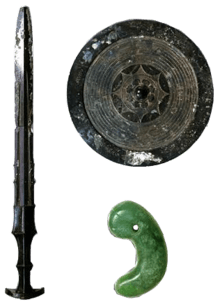 |
A sword and one of the Three Sacred Treasures of Japan that legitimize the rule of the Emperor. Lost at sea in the Battle of Dan-no-ura in the Genpei War.[1] Current government claims possession, but has not permitted outside verification. |
| Crown Jewels of England | Legend | 1216 | Baggage train of King John ("John Lackland"), lost in The Wash near Sutton Bridge during the First Barons' War. | |
| Llywelyn's coronet | Legend | 1303 | The coronet of Llywelyn ap Gruffudd, the last king of Wales, was seized along with other holy artifacts at the end of the Conquest of Wales by Edward I, in 1284 taken to London, and kept with the crown jewels in Westminster Abbey until they were stolen in 1303. It was not present in the inventory taken during the destruction of the crown jewels by Oliver Cromwell in 1649, and remains unaccounted for. | |
| La Noche Triste treasure | Partially Confirmed | 1520 | Large amount of gold looted from the palace of Moctezuma II. Occurred during the Spanish conquest of the Aztec Empire.[2] | |
| Lost Inca gold | Partially Confirmed | circa 1533 | Originally intended as part of the ransom of Inca Emperor Atahualpa it would have been hidden once it became known that Francisco Pizarro's men had killed him.[3] | |
| The Three Brothers | Confirmed | 1645 | 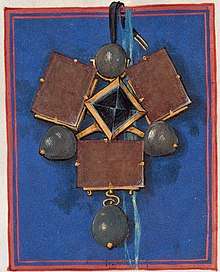 |
A piece of jewellery created in 1389, made of three red spinels in a distinctive triangular arrangement around a central diamond.[4] Owned by key medieval figures such as Duke John the Fearless of Burgundy, the German banker (and richest man in history) Jakob Fugger, and English monarchs Elizabeth I, James VI and I, and Charles I. Part of the English Crown Jewels from 1551 to 1644, when it was possibly sold by the wife of Charles I. It vanishes from records after 1645.[5] |
| Treasure of Amaro Pargo | Likely | 1678-1747 |  |
The treasure would be composed of "carved silver, gold jewelry, pearls and stones of value, Chinese porcelain, rich fabrics, paintings and perhaps 500,000 pesos".[6] The stories about this treasure are varied, some place it in the environment of the Roques de Anaga, while others place it in the zone of Punta del Hidalgo and the cave of San Mateo, northeast of Tenerife in the Canary Islands. |
| Loch Arkaig treasure | Legend | 1745 | The treasure of Loch Arkaig, sometimes known as the Jacobite gold, was a large amount of specie provided by Spain to finance the Jacobite rising in Scotland in 1745, and rumoured still to be hidden at Loch Arkaig in Lochaber. | |
| Scepter of Dagobert | Confirmed | 1795 | Originally part of the French Regalia, sometimes considered its oldest part, dating from the 7th century, it was stored in the treasure of the Basilica of Saint-Denis (also known as Basilique royale de Saint-Denis) until 1795, when it disappeared, probably stolen. | |
| Oak Island money pit | Legend | 1795 | A possible treasure trove located in a large hole on an island off the coast of Nova Scotia, Canada.[8][9] | |
| Treasure of the Esperanza | Legend | 1816 | 1.5 million gold pesos and an equal value in silver precolumbian art looted from the Viceroyalty of Peru, shipped on the Esperanza, taken and buried by pirates shipwrecked on Palmyra Atoll.[10] | |
| Treasure of Lima | Likely | 1820 | Gold, silver and jewelry stolen from the Spanish in 1820. The treasure is thought to be buried on Cocos Island in Costa Rica and it is estimated to be worth £160 million.[11] | |
| Confederate gold | Legend | circa 1865 | Gold from the Confederacy. Lost after the American Civil War. | |
| Twin Sisters | Confirmed | 1865 |  Replicas featured at San Jacinto Monument |
A pair of cannons used by Texas Military Forces during the Texas Revolution and American Civil War. Considered the "Texas Holy Grail." |
| Tokugawa's buried treasure | Legend | circa 1868 | A legendary treasure allegedly buried in Mount Akagi by the Tokugawa shogunate (disputed). | |
| Kruger Millions | Legend | 1902 | Millions of gold pounds presumed to have been produced by the Boer forces in the South African veld under order of President Paul Kruger. The money was believed to fund the purchase of weapons for the Boer Commandos. The funds went missing. Believed to have been buried or hidden somewhere in South Africa or taken by Kruger to Switzerland. | |
| Crown Jewels of Ireland | Confirmed | 1907 | 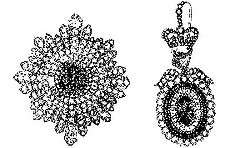 |
Heavily bejeweled insignia of the Most Illustrious Order of St Patrick. Stolen from Dublin Castle in 1907. |
| The Tsar's Treasure | Partially Confirmed | 1909 | $3 million in newly minted American double eagle coins sent to the Russian Baltic Fleet, an $800,000 US Government shipment in mixed coin to the American Atlantic Fleet, and the confirmed loss of $500,000 in passenger effects (all 1909 values) were lost when the RMS Republic foundered off the coast of New England as a result of a collision. | |
| Romanian Treasure | Confirmed | 1917 | The gold reserves (approx. 120 tonnes) of the Romanian government and other valuables sent to Russia for safekeeping during World War I. These were mislaid after the October Revolution and only some of the objects, and none of the gold reserves, have been returned as of 2020. | |
| Florentine Diamond | Confirmed | 1918 | 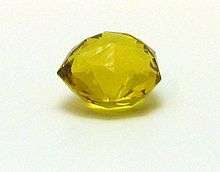 |
Lost yellow diamond with Indian origin. |
| Lost Imperial Fabergé eggs | Confirmed | 1922 or later | 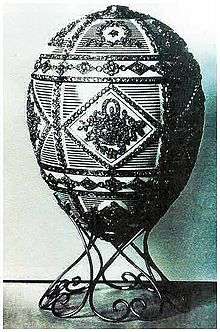 |
Six eggs in the Imperial series are missing:[12]
|
| The Just Judges | Confirmed | 1934 |  |
Lower left panel of the Adoration of the Mystic Lamb, which was displayed at the Saint Bavo Cathedral in Ghent, Belgium, was stolen during the night of 10 April 1934. |
| Royal Casket | Confirmed | 1939 | Memorial containing 73 precious relics[17] that had once belonged to Polish royalty. Looted by the Wehrmacht during the German invasion of Poland at the beginning of World War II. | |
| Sword of Islam | Confirmed | 1943 |  |
Ceremonial sword presented to Benito Mussolini in 1937 from Berber collaborators in Italian Libya.[18] Disappeared in July 1943, after his summer residence was destroyed by the Italian Resistance.[19] |
| Peking Man | Confirmed | 1941–1945 | _presented_at_Paleozoological_Museum_of_China.jpg) |
Fossil remains of Homo erectus pekinensis; dated ~500,000 years old. Lost during World War II in China in 1941 when the U.S. Marine Corps moved them out of Japanese-occupied Beijing or may have been on the Awa Maru when it sank in 1945.[20] |
| Amber Room | Confirmed | circa 1945 |  |
Removed from Catherine Palace, Saint Petersburg, by Army Group North during the German invasion of the Soviet Union and transported to Königsberg, Germany. Estimated (adjusted) value: $142 million. Reconstructed in 2003.[21] |
| Yamashita's gold | Legend | circa 1945 | War loot stolen by the Imperial Japanese Army from Southeast Asia and hidden in the Philippines. Alleged. Named for General Tomoyuki Yamashita. | |
| Awa Maru treasure | Legend | 1945 | Gold, platinum, and diamonds worth more than $5 billion. Lost when the Japanese ship Awa Maru was torpedoed by the USS Queenfish and sank in April 1945.[22] | |
| Nazi gold train | Legend | 1945 | A train laden with gold and other treasures hidden by the Nazi Germans in a tunnel near Wałbrzych in Lower Silesia, Poland. | |
| Honjō Masamune | Confirmed | 1945 | The Honjō Masamune, a legendary samurai sword, created by the master swordmaker Gorō Masamune between 1288 and 1328 AD. The sword was passed down over the centuries from Shōgun to Shōgun, and is considered a priceless Japanese cultural artifact. Lost during the U.S. occupation of Japan. | |
| Patiala Necklace | Confirmed | circa 1948 | 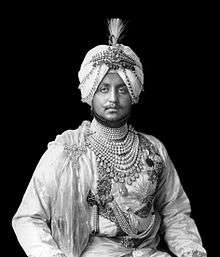 |
Made by the House of Cartier in 1928 for Bhupinder Singh of Patiala, then Maharaja of Patiala. A necklace containing 2,930 diamonds including the world's seventh largest diamond, the 428 carat "De Beers", the Patiala Necklace vanished from the Royal Treasury of Patiala around 1948. Some diamonds were later recovered. |
| Nelson's Chelengk | Confirmed | 1951 |  |
A medal made of diamonds given to Admiral Horatio Nelson by the Ottoman Empire for his naval service in the Battle of the Nile. Placed in the National Maritime Museum in London in 1929 and stolen in 1951. |
| Tucker's Cross | Confirmed | 1975 | Emerald-studded gold cross, discovered in a shipwreck in 1955 and stolen from a museum in Bermuda sometime prior to 1975, when it was discovered to have been replaced with a fake.[23] | |
| Lufthansa heist | Confirmed | 1978 | Cash and jewels from a robbery at Lufthansa's cargo terminal at John F. Kennedy International Airport in December 1978. With a value of about $5 million, it was the largest cash robbery in the United States at the time.[24] | |
| Argentine flag in the Falkland Islands | Confirmed | 1982 |  The buried Argentina Flag |
Argentine Flag buried by the Argentine soldiers who fought during the Falklands War.[25] |
| Brink's-Mat robbery | Confirmed | 1983 | Gold bullion, diamonds, and cash valued at £26 million (worth approximately £79 million in 2015) | |
| Isabella Stewart Gardner Museum heist | Confirmed | 1990 | Thirteen works of art valued at $500 million were stolen from the Isabella Stewart Gardner Museum by two men posing as police officers. The art was mostly stolen from the museum's Dutch Room and included pieces by Rembrandt and Vermeer. [26] | |
| Antwerp Diamond heist | Confirmed | 2003 | Diamonds, gold and other jewels worth $189 million. Dubbed the "heist of the century".[27] | |
| Graff Diamonds robbery | Confirmed | 2009 | 43 items of jewelry, stolen in London on 6 August 2009. Valued at nearly £40 million.[28] | |
| Ivory Coast Crown Jewels | Confirmed | 2011 | Around 80 objects were stolen from the Museum of Civilisations in Abidjan, including gold pendants, necklaces, masks, sculptures and religious artifacts worth an estimated $6 million.[29][30] | |
| Brussels Airport diamond heist | Confirmed | 2013 | Diamonds stolen from a Helvetic Airways Fokker 100 at Brussels Airport valued at $50 million.[31] | |
| Hatton Garden safe deposit burglary | Confirmed | 2015 | Safe deposit facility burgled in London, total stolen could have been up to £200M | |
| Dresden Green Vault heist | Confirmed | 2019 | Diamond jewelry sets, a sword with a diamond-encrusted handle, several shoe buckles and buttons made of diamonds, and parts of a diamond necklace belonging to Queen Amalie Auguste from 1824. Valued at nearly €1 billion. |
See also
- Art theft and looting during World War II
- Looted art
- Lost artworks
- Lost film
- List of lost television broadcasts
- Lost history
- Lost work
- Nazi gold
- Nazi plunder
References
- McCullough, Helen Craig (1988). The Tale of the Heike. Stanford: Stanford University Press. ISBN 0-8047-1418-5.
- Prescott, William H. (2001). History of the Conquest of Mexico. ISBN 0-375-75803-8.
- James, Owen. "Lost Inca Gold". National Geographic.
- SusanGems. "The Three Brethren, the Burgundian Crown Jewel". Retrieved 5 August 2020.
- Strong, Roy (1966). "Three Royal Jewels: The Three Brothers, the Mirror of Great Britain and the Feather". The Burlington Magazine. 108 (760): 350–353. ISSN 0007-6287.
- Sánchez, Almudena. "La ruta del pirata Amaro". Canarias7. Las Palmas de Gran Canaria. Archived from the original on 15 January 2016. Retrieved 17 July 2016.
- Dom Bernard de Montfaucon, Les monuments de la monarchie françoise (1729) Paris, plate III (between pages xxxiv/v)
- "DAVID MURDOCK: Oak Island's Money Pit". GadsdenTimes.com.
- "Oak Island Money Pit has drawn treasure seekers for centuries". Slate Magazine.
- Connor, Martin (14 April 1923). "Priceless Treasures of the Incas May Be Buried on Island in Palmyras". Honolulu Star-Bulletin. Honolulu. p. 1. Archived from the original on 14 August 2017. Retrieved 14 August 2017.
- Copping, Jasper (5 August 2012). "British expedition to Pacific 'treasure island' where pirates buried their plunder". The Daily Telegraph. Retrieved 16 October 2012.
- Website by Annemiek Wintraecken: Missing Fabergé Eggs
- Lowes, Will; McCanless, Christel Ludewig (2001). Fabergé Eggs A Retrospective Encyclopedia. Lanham, Maryland: Scarecrow Press Inc. p. 22. ISBN 0-8108-3946-6.
- Lowes, Will; McCanless, Christel Ludewig (2001). Fabergé Eggs A Retrospective Encyclopedia. Lanham, Maryland: Scarecrow Press Inc. p. 24. ISBN 0-8108-3946-6.
- "News & Research: The Lost Imperial Nécessaire Fabergé Easter Egg". Wartski. London: Wartski Ltd. Retrieved 15 December 2018.
- "Faberge — Treasures of Imperial Russia". Archived from the original on 13 April 2012.
- Barbara Kobielska. "Cenne, Bezcenne, Utracone (Valuable, Priceless, Lost)" (in Polish). Pagina. ISSN 1428-6467. Cite journal requires
|journal=(help) - "I rapporti tra il fascismo e il mondo arabo - islamico". www.arab.it. Retrieved 24 May 2019.
- Romersa, Luigi (September–October 1994). "Benito e Rachele Mussolini nella tragedia". Storia Verità. No. 17.
- "Sinking and salvage of the Awa Maru" (PDF).
- Blumberg, Jess (1 August 2007). "A Brief History of the Amber Room". Smithsonian. Retrieved 15 October 2012.
- Seagrave, Sterling; Seagrave, Peggy (2003). Gold Warriors: America's Secret Recovery of Yamashita's Gold. Verso. p. 203. ISBN 9781859845424.
name of Awa maru.
- "Bio of Bermuda Teddy Tucker". BerNews. Retrieved 4 November 2013.
- Fox, Margalit (13 June 2012). "Henry Hill, Mobster and Movie Inspiration, Dies at 69". The New York Times. Retrieved 16 October 2012.
- El misterio de la banderas y los sables enterrados en Malvinas
- https://www.gardnermuseum.org/about/theft-story
- Goldman, Russell (13 August 2009). "Stolen Jewels, Art and Cash: World's Biggest Heists". ABC News. Retrieved 15 October 2012.
- Edwards, Richard (11 August 2009). "Graff Diamonds £40 million jewellery robbery is Britain's biggest gem heist". The Daily Telegraph. Retrieved 15 October 2012.
- Tovrov, Daniel (13 July 2011). "Thief! Ivory Coast's Crown Jewels Stolen". International Business Times. Retrieved 15 October 2012.
- James, John (13 July 2011). "Ivory Coast loses its crown jewels". BBC News. Retrieved 6 August 2020.
- Chrisafis, Angelique (19 February 2013). "Diamond heist at Brussels airport nets gang up to £30m in gems". The Guardian. Retrieved 19 February 2013.
External links
This article is issued from Wikipedia. The text is licensed under Creative Commons - Attribution - Sharealike. Additional terms may apply for the media files.
